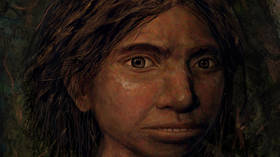Putting on a brave face: ‘Denise’ offers us our first look at the long-lost Denisovan race (PHOTOS)

The mystery surrounding the era of the Denisovans, the human race that went extinct about 50,000 years ago leaving almost no clue as to what they looked like, has finally been solved, with the face of a teenager named ‘Denise.’
Researchers at the Hebrew University of Jerusalem revealed Denise, a 13-year-old from Siberia, on Thursday. She’s the first reconstructed anatomical profile of the other human group that once roamed the planet alongside Neanderthals 100,000 years ago.
Also on rt.com Not even archaeology is safe: AI just discovered a new human speciesDenise was pieced together over a three-year period using a high-tech analysis of the group’s ancient DNA, derived from just three Denisovan teeth and the tip of a bone from her pinkie finger discovered in 2008. A later discovery of a lower jaw bone further confirmed the team’s recreation.
DNA reveals first look at our mysterious human relative. @HebrewU Prof. Liran Carmel and colleagues put together best model yet of the species' skeleton...and likeness. Meet Denise, the 13 yr old Denisovan from Siberia. Credit: Maayan Harel. pic.twitter.com/E5Mhl1uXd2
— Hebrew University (@HebrewU) September 19, 2019
RM: https://www.rt.com/news/449845-human-dna-ai-species/
“One of the most exciting moments happened a few weeks after we sent our paper to peer review,” said Hebrew University researcher Prof. Liran Carmel, who led the study, which has been published in Cell Press.
“Scientists had discovered a Denisovan jawbone. We quickly compared this bone to our predictions and found that it matched perfectly. Without even planning it, we received independent confirmation of our ability to reconstruct whole anatomical profiles using DNA that we extracted from a single fingertip.”
Deciphering anything more than a person’s hair or skin color from a DNA sequence is incredibly difficult, according to Carmel. However, a process called DNA methylation, in which methyl groups are added to the DNA molecule, allows researchers to make a much more detailed anatomical profile.
A revolutionary study by Israeli @HebrewUniversity researchers has managed to produce an 85% accurate reconstructions of our long-lost Denisovan relatives based on patterns of methylation (chemical changes) in their ancient DNA. Results are revelatory!🔗https://t.co/PmXBDjOKGJpic.twitter.com/8zMjGFwnDb
— Elad Ratson (@EladRatson) September 20, 2019
The team claims this Denise model is about 85 percent accurate by applying the same methodology to the known anatomical profiles of Neanderthals and chimpanzees. Denisovans, who once lived in Siberia and Eastern Asia, were found to bear a striking resemblance to humans
“In many ways, Denisovans resembled Neanderthals but in some traits they resembled us and in others they were unique,” added Carmel.
Think your friends would be interested? Share this story!














